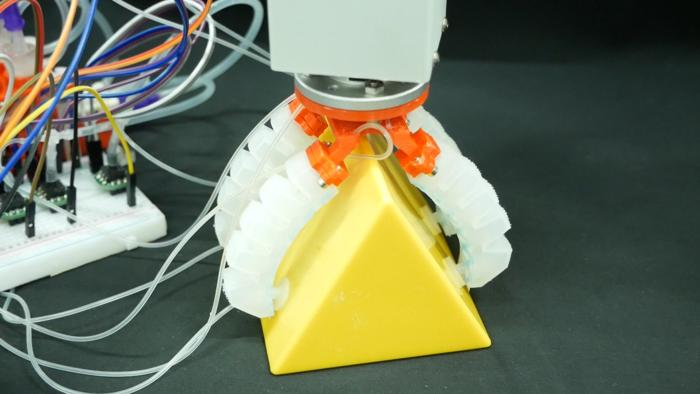A team from the University of Bristol’s Faculty of Science and Engineering has developed a simple yet ingenious robot that uses fluid flows - of air or water - to coordinate suction and movement, much like an octopus does with its many arms and hundreds of suckers.
 Suction cups using suction intelligence to grasp object. Image Credit: Tianqi Yue
Suction cups using suction intelligence to grasp object. Image Credit: Tianqi Yue
The study, published today in Science Robotics, demonstrates how a soft robot can use suction flow not just to attach to surfaces, but also to sense its environment and guide its actions, similar to how an octopus operates. A single suction system allows the robot to grasp delicate objects, detect whether it's in contact with air, water, or a rough surface, and even estimate how much force is being applied to it, all without relying on a central computer.
Last year, we developed an artificial suction cup that mimicked how octopuses stick to rocks using soft materials and water sealing. This research brings that work on, from using a suction cup like an octopus sucker to connect to objects to using ‘embodied suction intelligence’ - mimicking key aspects of the neuromuscular structure of the octopus in soft robotic systems.
Tianqi Yue, Study Lead Author and Research Associate, University of Bristol
This suction-based intelligence functions on two levels. At a local level, by combining suction flow with embedded fluidic circuitry, soft robots can achieve low-level, octopus-like intelligence, such as gently gripping fragile items, curling adaptively, and enclosing objects of unknown shapes. And at a higher level, by interpreting pressure signals from the suction cup, the robot can detect contact, classify its surroundings and surface textures, and estimate pulling forces during interaction.
Because it’s simple and low-cost, this approach could lay the groundwork for a new class of soft robots that are safer, smarter, and more energy-efficient. Potential applications range from gently harvesting fruit in agriculture and handling delicate components in factories, to anchoring medical instruments inside the human body, or developing soft toys and wearable tools that interact safely with people.
The team is now focused on making the system smaller and more durable for practical deployment. They also plan to integrate it with smart materials and AI to enhance its adaptability and decision-making in complex settings.
Yue concluded, “It’s fascinating how a simple suction cup, with no electronics inside, can feel, think and act - just like an octopus arm. This could help robots become more natural, soft and intuitive to use.”
Journal Reference:
Yue, T., et al. (2025) Embodying soft robots with octopus-inspired hierarchical suction intelligence. Science Robotics. doi.org/10.1126/scirobotics.adr4264